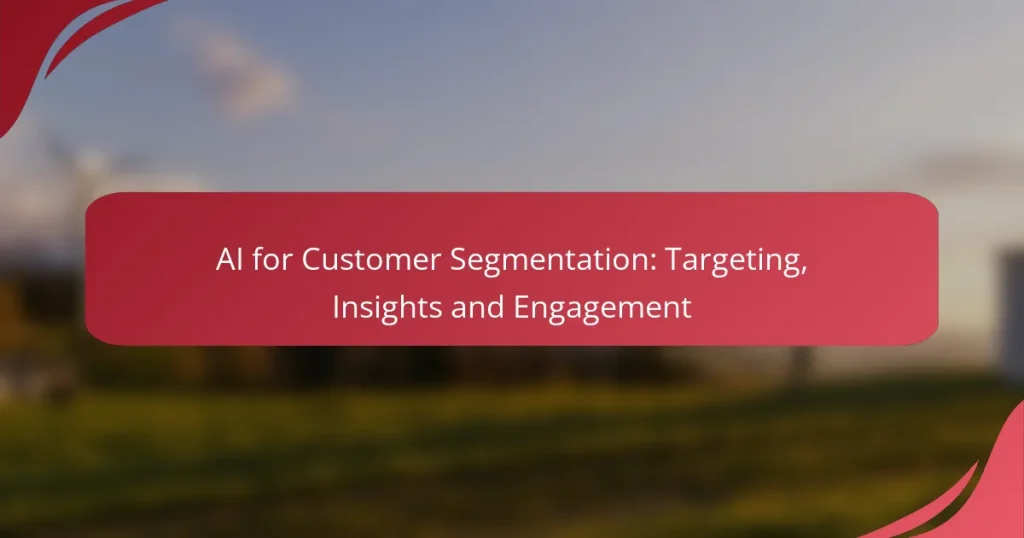AI for customer segmentation revolutionizes how businesses understand and engage with their audiences by analyzing extensive data to uncover patterns and preferences. This technology enables precise targeting and provides valuable insights into customer behavior, leading to more effective marketing strategies and enhanced customer interactions. By categorizing customers into distinct groups based on their behaviors and demographics, companies can drive sales growth and foster deeper connections with their clientele.
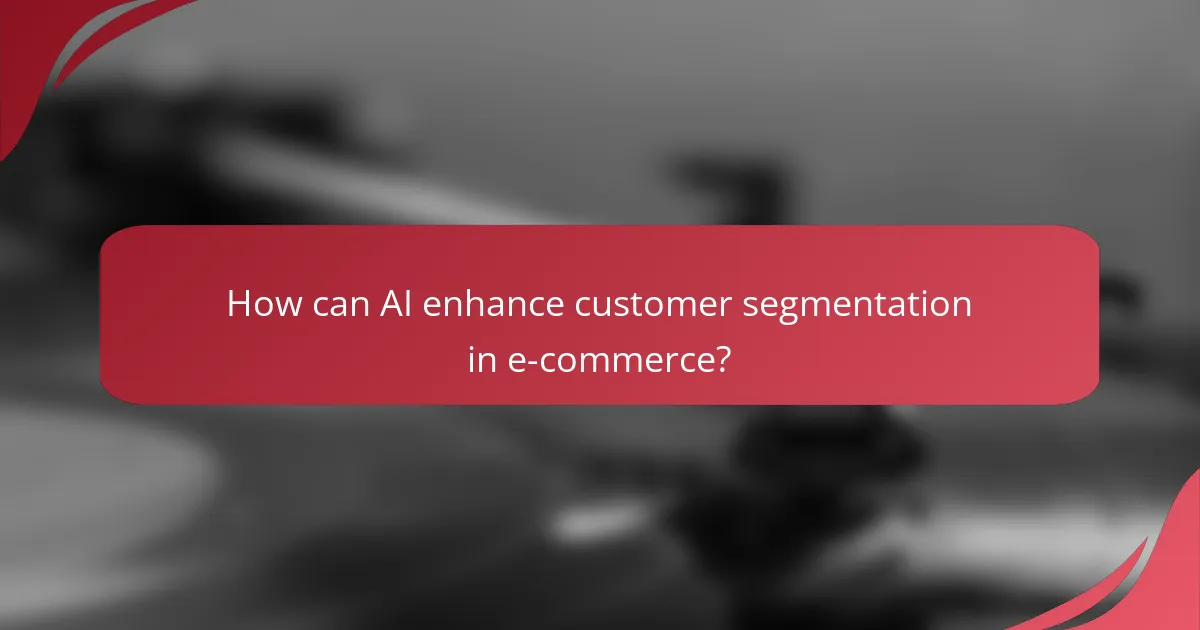
How can AI enhance customer segmentation in e-commerce?
AI enhances customer segmentation in e-commerce by analyzing vast amounts of data to identify patterns and preferences among consumers. This leads to more precise targeting, deeper insights into customer behavior, and more effective engagement strategies.
Improved targeting accuracy
AI algorithms can process customer data, such as purchase history, browsing behavior, and demographic information, to create highly specific customer segments. This allows e-commerce businesses to tailor marketing efforts to distinct groups, increasing the likelihood of conversion.
For example, an online clothing retailer might use AI to identify a segment of customers who frequently purchase athletic wear. By targeting this group with personalized promotions, the retailer can significantly boost sales in that category.
Increased customer insights
AI tools provide deeper insights into customer preferences and behaviors by analyzing data trends over time. These insights can reveal not only what products customers are interested in but also when they are most likely to make a purchase.
For instance, an e-commerce platform might discover that certain customers tend to shop during specific seasons or events. Understanding these patterns enables businesses to optimize inventory and marketing strategies accordingly.
Enhanced engagement strategies
With AI-driven segmentation, businesses can develop more personalized engagement strategies that resonate with different customer groups. This includes targeted email campaigns, personalized product recommendations, and tailored content on websites.
For example, a travel booking site could use AI to send customized offers based on a user’s past travel destinations and preferences, enhancing the overall customer experience and increasing loyalty.
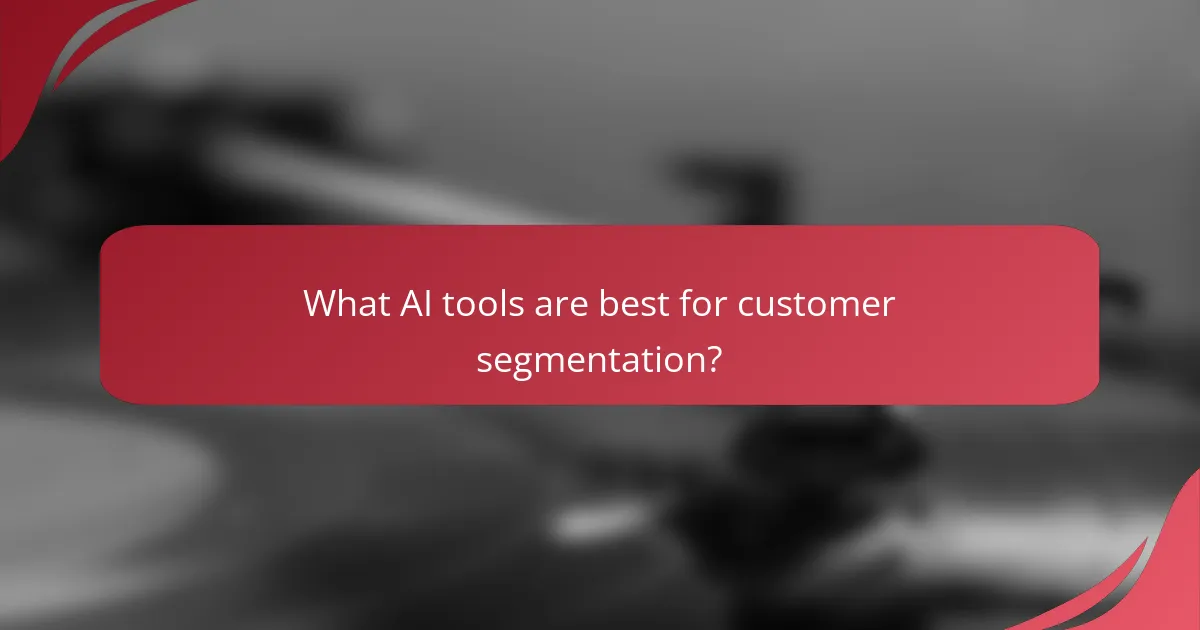
What AI tools are best for customer segmentation?
Several AI tools excel in customer segmentation by analyzing data to identify distinct groups within a customer base. These tools leverage machine learning algorithms to provide insights that enhance targeting and engagement strategies.
Segmentify
Segmentify uses AI to analyze user behavior and preferences, allowing businesses to create personalized marketing strategies. It offers real-time segmentation based on customer interactions, which helps in tailoring content and product recommendations effectively.
Key features include automated segmentation updates and the ability to integrate with various e-commerce platforms. Businesses can expect improved conversion rates by delivering relevant content to specific customer segments.
Bluecore
Bluecore specializes in retail marketing automation, utilizing AI to segment customers based on their shopping behaviors and preferences. Its platform enables marketers to create targeted campaigns that resonate with different customer groups, enhancing engagement and retention.
The tool provides insights into customer journeys, allowing for timely and relevant communications. Users can leverage Bluecore’s predictive analytics to anticipate customer needs and optimize marketing efforts accordingly.
Optimove
Optimove focuses on relationship marketing and customer retention through advanced segmentation techniques. It analyzes customer data to identify valuable segments and create personalized marketing campaigns that drive loyalty.
With features like automated campaign management and performance tracking, Optimove helps businesses refine their strategies based on real-time feedback. This tool is particularly beneficial for companies looking to enhance customer lifetime value through targeted engagement efforts.
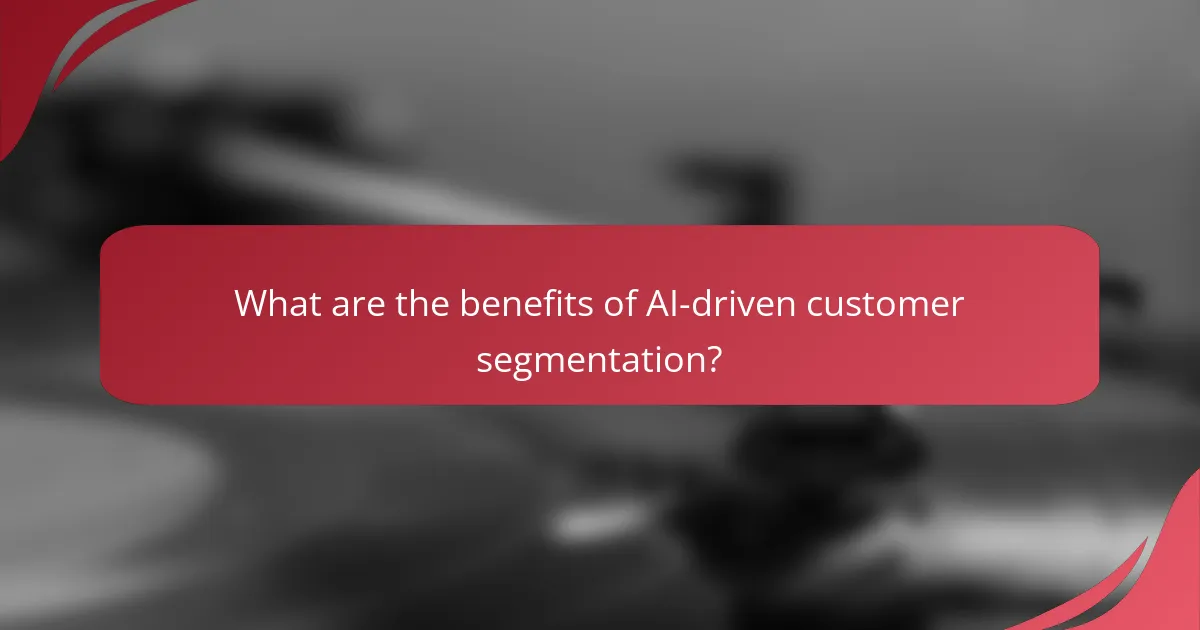
What are the benefits of AI-driven customer segmentation?
AI-driven customer segmentation offers businesses the ability to categorize their customers into distinct groups based on behavior, preferences, and demographics. This targeted approach enhances marketing strategies, improves customer interactions, and ultimately drives sales growth.
Personalized marketing campaigns
With AI-driven segmentation, companies can create highly personalized marketing campaigns tailored to specific customer groups. By analyzing data such as purchase history and online behavior, businesses can craft messages that resonate with individual preferences, leading to a more engaging customer experience.
For example, a retail brand might use AI to identify a segment of customers who frequently purchase athletic wear. They can then send targeted promotions for new arrivals in that category, increasing the likelihood of conversion.
Higher conversion rates
AI segmentation can significantly boost conversion rates by ensuring that marketing efforts are directed toward the most receptive audiences. By understanding which segments are more likely to respond to particular offers, businesses can optimize their campaigns for maximum impact.
Research indicates that targeted campaigns can achieve conversion rates that are several times higher than generic marketing efforts. This means that businesses can expect a better return on investment (ROI) by focusing their resources on well-defined customer segments.
Efficient resource allocation
Implementing AI-driven customer segmentation allows businesses to allocate their resources more efficiently. By identifying high-value segments, companies can prioritize their marketing budgets and efforts toward those groups that are most likely to yield significant returns.
For instance, a company might discover that a small percentage of customers generates a large portion of its revenue. By focusing on retaining and upselling to this segment, they can optimize their marketing strategies and reduce waste in their advertising spend.

How does AI analyze customer data for segmentation?
AI analyzes customer data for segmentation by leveraging advanced algorithms to identify patterns and group customers based on shared characteristics. This process enhances targeting, provides deeper insights, and improves engagement strategies.
Machine learning algorithms
Machine learning algorithms are at the core of AI-driven customer segmentation. They process vast amounts of data to uncover hidden patterns that traditional methods might miss. Common algorithms include clustering techniques like K-means and hierarchical clustering, which categorize customers based on similarities in behavior, demographics, or purchasing history.
When implementing machine learning for segmentation, it’s crucial to select the right features that represent your customer base effectively. Regularly updating the model with new data ensures that the segments remain relevant and actionable.
Predictive analytics
Predictive analytics uses historical data to forecast future customer behavior, allowing businesses to tailor their marketing strategies accordingly. By analyzing trends and patterns, companies can predict which segments are likely to convert or churn, enabling proactive engagement efforts.
For effective predictive analytics, consider using tools that integrate seamlessly with your existing data systems. This integration allows for real-time analysis and helps in adjusting strategies based on emerging trends.
Behavioral analysis
Behavioral analysis focuses on understanding how customers interact with products and services. By tracking actions such as website visits, purchase history, and social media engagement, businesses can create detailed profiles that inform segmentation strategies.
Utilizing tools like heatmaps and customer journey mapping can provide insights into customer behavior. This information is vital for creating targeted campaigns that resonate with specific segments, ultimately driving higher engagement and conversion rates.
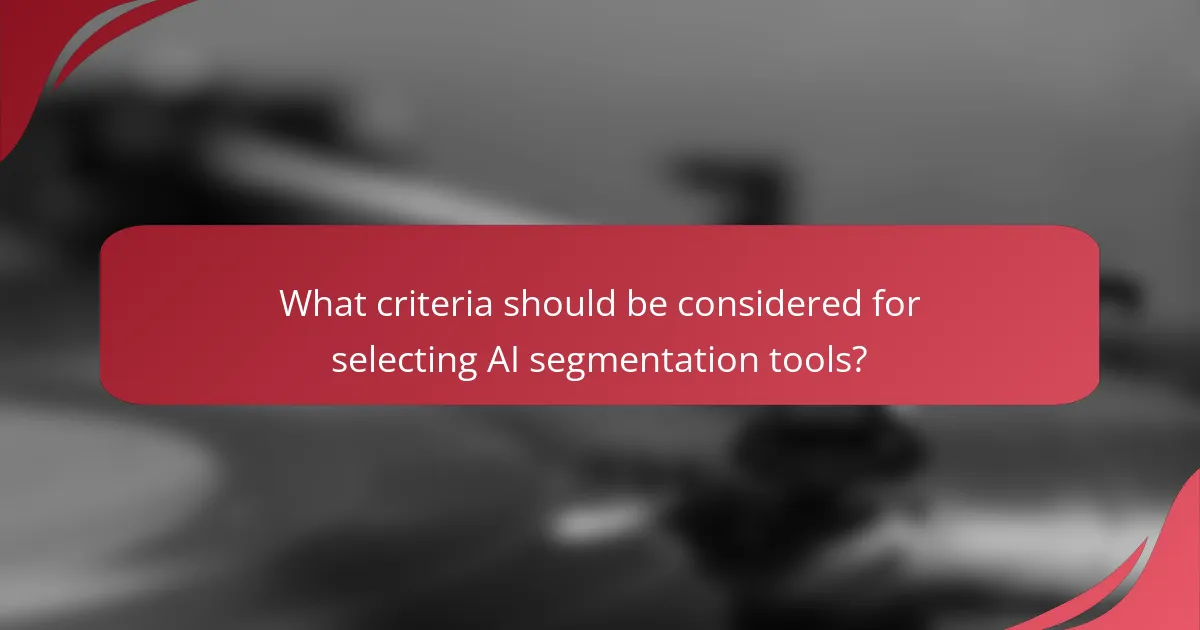
What criteria should be considered for selecting AI segmentation tools?
When selecting AI segmentation tools, consider integration capabilities, scalability, and cost-effectiveness. These criteria ensure that the tool aligns with your existing systems, can grow with your business, and fits within your budget.
Integration capabilities
Integration capabilities refer to how well the AI segmentation tool can connect with your existing software and data sources. A tool that seamlessly integrates with your CRM, marketing platforms, and analytics systems can significantly enhance data flow and usability.
Look for tools that offer APIs or pre-built connectors to popular platforms. This reduces the time and resources needed for implementation and helps maintain data consistency across systems.
Scalability
Scalability is crucial for ensuring that the AI segmentation tool can handle increasing amounts of data and users as your business grows. A scalable solution allows you to expand your customer base without compromising performance or requiring a complete system overhaul.
Evaluate whether the tool can accommodate larger datasets and more complex segmentation needs over time. Consider options that offer tiered pricing or features that can be unlocked as your requirements evolve.
Cost-effectiveness
Cost-effectiveness involves assessing whether the benefits of the AI segmentation tool justify its price. Look for tools that provide clear ROI through improved targeting and engagement, which can lead to higher conversion rates.
Compare pricing models, such as subscription fees versus one-time payments, and consider any additional costs for training or support. Aim for solutions that offer flexible pricing based on usage, ensuring you only pay for what you need.
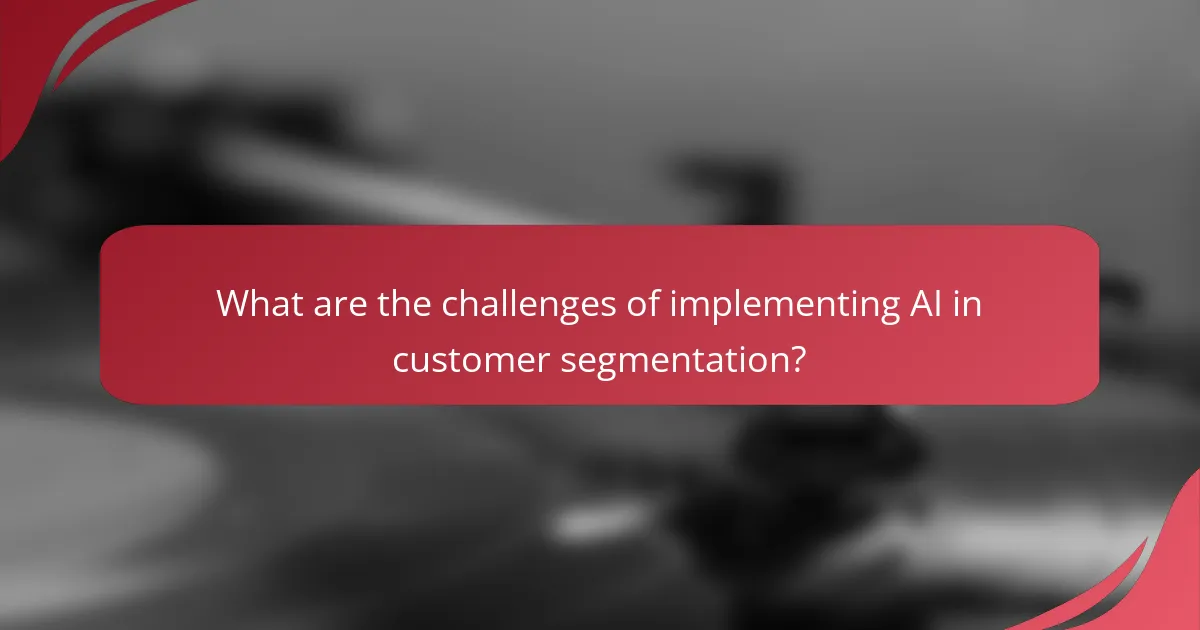
What are the challenges of implementing AI in customer segmentation?
Implementing AI in customer segmentation presents several challenges that can hinder effective deployment. Key issues include data quality, integration complexities, and the need for skilled personnel to interpret AI insights.
Data Quality and Availability
High-quality data is essential for accurate customer segmentation using AI. Inconsistent, incomplete, or outdated data can lead to misleading insights. Organizations should prioritize data cleansing and ensure they have access to comprehensive datasets, including customer demographics, behaviors, and preferences.
To improve data quality, consider regular audits and updates. Employing data validation techniques can help maintain accuracy. Additionally, integrating data from various sources, such as CRM systems and social media, can provide a more holistic view of customer segments.
Integration with Existing Systems
Integrating AI tools with existing customer relationship management (CRM) systems can be complex. Organizations often face challenges in aligning AI technologies with their current infrastructure and processes. It is crucial to assess compatibility and plan for potential disruptions during the integration phase.
To ease integration, start with pilot projects that allow for gradual implementation. This approach helps identify issues early and allows teams to adapt their strategies without overwhelming existing systems. Collaboration between IT and marketing teams is vital for a smooth transition.
Skill Gaps and Training Needs
Implementing AI in customer segmentation requires specialized skills that may be lacking in many organizations. Data scientists and AI specialists are often in high demand, making it challenging to find qualified personnel. Investing in training programs for existing staff can help bridge this gap.
Consider offering workshops and courses on AI tools and data analysis techniques. Partnering with educational institutions or online platforms can provide valuable resources. Encouraging a culture of continuous learning will empower teams to leverage AI effectively in their segmentation efforts.
